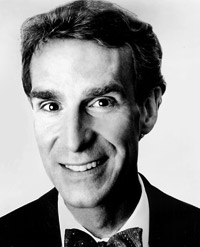A Tribute to Carl Sagan:
Our Place in the Universe
That idea, that bit right there, is the insight that he extolled in life — in his lectures, his writing, and especially in his remarkable Cosmos series and book. It’s the idea that we inhabit a world that is an ordinary planet among what must be, if I may, billions and billions of planets. And wait; there’s more. Despite those billions, our planet and its children must be extraordinary. We won the cosmic lottery. We exist, and we get to know it. He drilled us on the notion that we are made of cosmic dust, star stuff. And that we somehow came to be is astonishing. Therefore fellow citizens, we must be good stewards of our world.
For Carl Sagan environmental awareness and stewardship are a logical consequence of space exploration. He wrote and lectured extensively on our place in the universe. He compared our 20th century space missions to the voyages of European and Asian ocean-going explorers of four and five centuries earlier. He did important research and drew compelling parallels to how we live now, and how our ancestors lived then. From what seemed disparate facts, he wove compelling stories and drew important and world-changing conclusions.
Nowadays it is common to hear people discuss the Cold War as though it were an event, one that was declared and concluded. But in those days, perhaps the 30 years that followed World War II, no one was talking about winning this undeclared amorphous war. There just were two super-powers, and each was somehow justified in doing whatever it took to bring the other one to its knees. In the midst of all the mistrust, Sagan encouraged scientists in the U.S. to engage scientists in the Soviet Union.
Then, Sagan made an extraordinary claim based on extraordinary and convincing analysis. If these two headlong rushing governments actually did exchange their enormous stockpiles of nuclear weapons, the world would pretty much end for everybody through “nuclear winter.” Once again, he used an astronomical perspective to prove a point. It seemed to me, a newly franchised voter and taxpayer, this was an argument that just couldn’t be ignored. Carl Sagan raised the consciousness (a phrase of his time) of the world about the real possibility of an ancient dinosaur-style death for everybody. Only this time, it would be our own fault. Sure enough, within a couple of years, this analysis fell on enough ears for the two governments influenced by citizens of Earth everywhere to stand down.
Sagan won a Pulitzer Prize for Dragons of Eden, an elegant treatise on evolution and the significance of the theory for understanding human behavior and society. As Carl pointed out often, having a technologically advanced military at the disposal of a scientifically illiterate society is a formula for disaster. Evolution is the unifying idea in all of biology. He wanted the world to know it as he did. We came from the stars, and the process is as glorious as the night sky. It’s not something to be suppressed or twisted to a thoughtless world-view of convenience.
The sky at night is a remarkable thing to behold. Even stranger and more moving is the vision of the night sky from places beyond Earth. Every day I ponder my place in the cosmos with thoughts illuminated by the image of the Earth as, Sagan called it, a “Pale Blue Dot.” From far, far away, we are all, every one of us, every one who has ever lived, pictured together on a single pixel, one dot of light vaguely visible in the dusty glow of a sunbeam. He wrote a book about it. He changed the world again.
In his classes, Sagan often showed us pictures from other worlds, most notably Mars. He carefully pointed out that our world and the world of Mars are very nearly identical, but differ in lifechanging ways. He also compared our world to Venus. Then he left us with the fundamental insight that I hope influences all humans everywhere. Life needs water, and water exists in all three phases — solid, liquid, and gas — only when a planet is placed just right. Ours is, as he often said, an in-between world. It is, astronomically speaking, in the balance between hot and cold, between dry and wet, and ultimately between life and death. As global climate changes become more and more apparent, a planetary perspective is going be essential for us humans to figure it out and take steps to keep our world livable for as many of us as possible. Carl Sagan described the human species as “space-faring.” That changed the world for me. I hope his legacy continues to change the world for all of us.
This article can be found in
volume 13 number 1
The Legacy of Carl Sagan
this issue includes: An Interview with Ann Druyan; Science, Religion & Human Purpose; An excerpt from Conversations with Carl; Tributes to Carl Sagan…BROWSE this issue >
This issue is sold out.



No comments:
Post a Comment
Please keep all comments civil. Please keep any arguments rational.
Thank you.